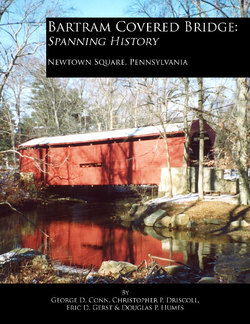Читать книгу Bartram Covered Bridge: Spanning History - George D. Conn - Страница 8
На сайте Литреса книга снята с продажи.
Selecting the Bridge Builder
ОглавлениеHaving received the report that a bridge spanning Crum Creek was necessary, the County Commissioners of the two counties met on April 13th, in Chadd’s Ford, to draw up the specifications for the construction of the bridge. On April 16th, the commissioners advertised in the local papers for people to bid on the contract to build the bridge.
During the early months of 1860, ten sealed bids were received. The bids were opened on May 7th and the contract was awarded to Ferdinand Wood. Wood had submitted the lowest bid at $1,133. The nine other bids ranged from a low of $1,195 to a high of $1,600. Among the other bidders was Eli Lewis, owner of the land on the Newtown side of Crum Creek, and Israel Bartram, the owner of the land on the Willistown side of Crum Creek. Lewis and Bartram submitted a combined bid of $1,400.
Mordecai T. Bartram, the 17 year old son of Israel Bartram, recorded in his diary, dated May 10, 1860, the following:
“To-day is wet. Vandalier Eachus came up and went to West Chester
along with father and Eli Lewis – he being one of the commissioners from
Delaware County and was going to West Chester to meet the rest of the
commissioners for the purchase of letting the bridge out to contractor.
Father and Eli put in 14 hundred but did not get it as one by the name of
Wood only put in $1,133.00 and as he is a reliable man he gets the bid”
The Bridge is Built
Ferdinand Wood built Bartram Bridge between May and September, 1860. From portal to portal the bridge was 60 feet in length. Ten foot wingwalls on each side brought the over-all length to 80 feet. The bridge had a width of 13 feet. It is often written that the original specifications required Wood to build the bridge as “hi and wide as a load of hay.” To support and strengthen the bridge, Wood used a Burr Arch truss.
We don’t know many of the details of the actual construction. However, it is fairly certain that the wood, stone and other materials, along with the labor, were all locally provided. Local materials and labor were the common practice. The use of local lumber in the construction of Bartram Bridge would seem to be confirmed by Israel Bartram’s granddaughter, Anna. In his book, Pictorial History of Chester County Covered Bridges, Spencer Windle cites Anna as saying that “tall trees stood in Israel and Maryann Bartram’s woods” and that “a sawmill on the farm would make strong beams and boards for a bridge.”
Another Bartram relative, M. Thomas Bartram, in a letter written to the Bartram Bridge Joint Board, in June of 1994, offered the following insight concerning the construction lumber:
“Israel bid on the bridge but lost by about $100 - however much of the timbers were cut from his land, so possibly he made out OK!!”
We also know that, in that same year of 1860, Ferdinand Wood was building another covered bridge in northern Maryland. We can speculate that Wood was busy traveling back-and-forth as he directed the construction at both sites. He most likely had a foreman and a number of workers at each site.
An article that appeared in the Philadelphia Bulletin on May 2, 1938, included interesting information about covered bridges. Two items mentioned are useful at this point. They give a little insight on the cost of things in that time period as they pertained to the building of a covered bridge. Although the writer is most likely referring to costs in the era of 1830, things really hadn’t changed that much by 1860. Here are two short excerpts from the article:
“Itemized records in one case showed that the foreman got $1 a day and
the carpenters 50 cents. Lumber, frequently obtained in proximity to the
bridge site, was cheap, and on the $1,150 bridge amounted to only $300.
Foundation preparation is one of the expensive items today, but when
the covered bridges were going up, a single foundation often cost no more
than $15, representing about two weeks of work for two men.”
Having received the contract to build the bridge in early May, 1860, Wood completed the bridge by early September. On September 19, 1860, it was reported to the Chester County Court of Quarter Sessions that the bridge was completed and ready to be inspected.
What a different time this is! Bartram Bridge today could cost a million dollars to build and the process could take years. Ferdinand Wood erected the bridge for $1,133 and did it in approximately 4 months.
